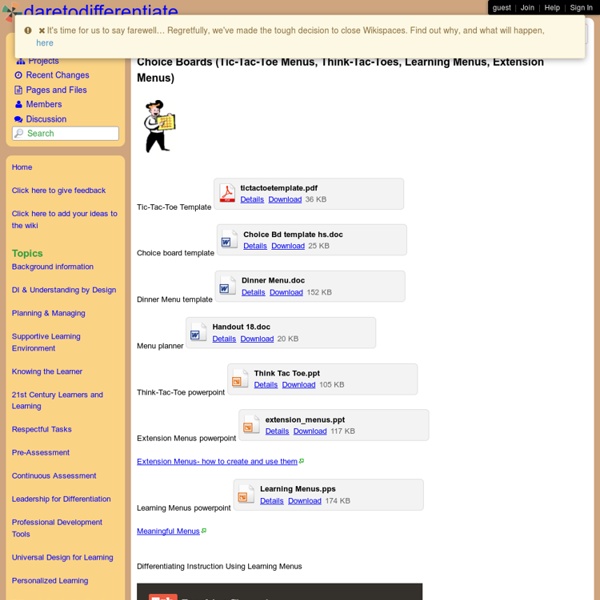



Digital Differentiation Tools for Teachers Digital differentiation is a new concept we learned from our colleague Susan Oxnevad. She did a really wonderful job crafting and designing the tools for digital differentiation which I am sharing with you below in the form of interactive images created using Thinglink. What is digital differentiation According to Susan, digital differentiation is all about designing and facilitating student driven learning experiences that are fuelled by standard based essential questions and powered by digital tools to provide students with flexible learning paths for success. Why digital differentiation ? Differentiating Instruction through Technology: Meeting the Needs of All Students Thematic Starting Points Start with the 42explore site. Then, look for the same 2-3 topics in other thematic starting places. Compare and contrast the results. How would these resources be helpful in addressing the individual differences in children such as reading level, interests, and depth? Explore 42explore Projects - topic or subject index. Library Portals for Children and Young Adults Pathfinder Collections Library Spot Web Subject Guides & Thematic Resources
Teaching . . . Seriously: Crafty Nonfiction Choice Boards This year, I'm asking my students to read one nonfiction picture book each week. To make it more engaging, I decided to develop a choice board. Not your everyday run-of-the-mill choice board, but something really crafty! My students will select one activity for each week of the first quarter. I couldn't wait to get started on these projects . . . so I decided to try them myself. Cootie Catcher Vocabulary - Choose four key vocabulary words from the text. Crafty Content Diagram - Think about the main idea or structure of the book. Paper Chain Summary - Cut strips of construction paper. Paper Bag Artifacts - Think about physical artifacts that would allow others to experience facts and ideas from the book. Paper Plate Compare/Contrast - You'll need to read two books with similar content for this activity. Main Idea Sticky Notes - Write the key ideas, principles, or events from the text on sticky notes. Enjoy! Brenda
The Ultimate List: 50 Strategies For Differentiated Instruction - The Ultimate List: 50 Strategies For Differentiated Instruction by Terry Heick Differentiation is a simple idea that’s less simple to actuate. Differentiation is a rational approach to meeting the needs of individual learners, but actually making it possible on a daily basis in the classroom can be challenge. In ‘What Differentiation Is–And Is Not: The Definition Of Differentiation,’ we recall ed-guru Carol Ann Tomlinson’s overview of differentiation as ‘adapting content, process, or product according to a specific student’s readiness, interest, and learning profile.’ And in ‘Understanding Differentiation’ “The goal of a differentiated classroom is maximum student growth and individual success. And therein lies the need for differentiation. Tomlinson’s above identification of ‘Content, Process, or Product’ provide a useful starting point, as she explains that, “A teacher can differentiate content. Below we’ve gathered a list of 50 differentiation strategies. 1. 2. 3. 4. 5. 6. 7. 8. 9. 10.
The Ultimate List: 50 Strategies For Differentiated Instruction - by Terry Heick Differentiation is a simple idea that’s less simple to actuate. Differentiation is a rational approach to meeting the needs of individual learners, but actually making it possible on a daily basis in the classroom can be a challenge. In ‘What Differentiation Is–And Is Not: The Definition Of Differentiation,’ we offered Carol Ann Tomlinson’s overview of differentiation as ‘adapting content, process, or product according to a specific student’s readiness, interest, and learning profile.’ And in ‘Understanding Differentiation,’ clarified the goal of differentiation in learning: “The goal of a differentiated classroom is maximum student growth and individual success. And therein lies the need for differentiation. How Can You Use Differentiation In Your Classroom? Tomlinson’s above identification of ‘Content, Process, or Product’ provide a useful starting point, as she explains that a “teacher can differentiate content. Below we’ve gathered a list of 50 differentiation strategies.
8 Ways to Differentiate a Worksheet | Classroom Tested Resources Do you struggle to make one worksheet work for your whole class? Are you trying to differentiate without pulling your hair out? I have been there, and I feel for you. While I am not a worksheet kind of teacher, I do understand that they have their time and place in just about every classroom. While they are necessary, they can be difficult to reach every student with, and in the modern classroom that poses some serious issues. Differentiation is such a buzzword these days, as it should be with individualized learning, but it can add a lot to a teacher's workload. It doesn't have to though! Highlighter A highlighter is a magical little tool. Sometimes I will ask the student which item they are struggling with and work with them on that item, and then highlight items that will compliment their learning based on that item. Evens or Odds Fold In Half This strategy, much like Evens or Odds works well when students should be completing about half of the items on a worksheet. Select Items 1. 2. 3.